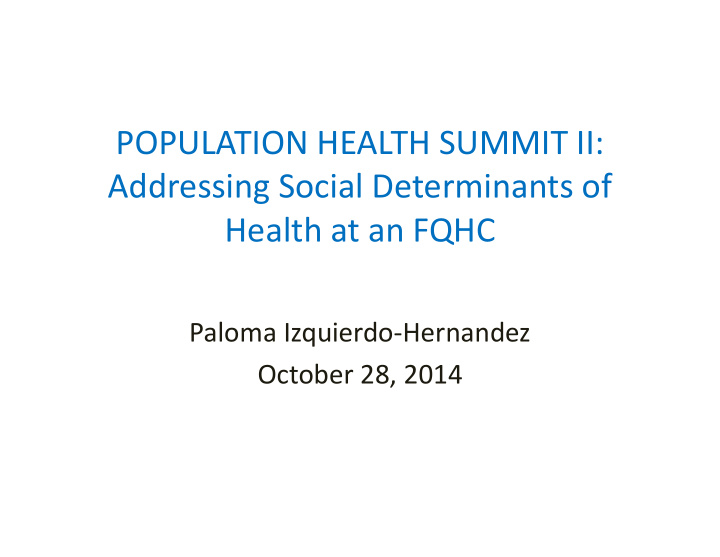



POPULATION HEALTH SUMMIT II: Addressing Social Determinants of Health at an FQHC Paloma Izquierdo-Hernandez October 28, 2014
URBAN HEALTH PLAN • Federally Qualified Community Health Center • Founded by Dr. Richard Izquierdo • Celebrating 40 years of service to the South Bronx and 5 years of service to the Corona Community • 21 practice sites • 9 practice sites • 9 school based health centers • 3 part time clinics • Numerous Support programs
BUDGET AND VISIT GROWTH Budget Visits Unique Patients 1974 $ 300,000 15,000 5,000 1990 $ 3.1m 63,000 12,600 2000 $ 10.8 m 85,000 16,500 2010 $ 40 m 211,000 43,000 2013 $ 70 m 305,000 60,000 2014 $ 78 m 340,000 67,000 Projected
SOCIAL DETERMINANTS OF HEALTH World Health Organization: The social determinants of health are the circumstances in which people are born, grow up, live, work and age, and the systems put in place to deal with illness. These circumstances are in turn shaped by a wider set of forces: economics, social policies, and politics. Healthy People 2020 The range of personal, social, economic, and environmental factors that influence health status are known as determinants of health. Determinants of health reach beyond the boundaries of traditional health care and public health sectors; sectors such as education, housing, transportation, agriculture, and environment can be important allies in improving population health.
URBAN HEALTH PLAN APPROACH SOCIAL-ECOLOGICAL FRAMEWORK
INTERNAL PATIENT LEVEL APPROACHES • Point of care screenings • Integration of support services • Continuum of Behavioral Health Services • Patient navigation through extensive telephone support • Nutrition Counseling and Waiting Room Presentations • 340b Drug Discount Program • Nurse care management • Use of community health workers • Interdisciplinary team meetings
INTERNAL SYSTEM LEVEL APPROACHES • Employment and Development • UHP Public Health Council • Community Outreach and Engagement • Multiple CBO Referral Agreements • Diversity and Inclusion that incorporates cultural and linguistic competence • Health Literacy and Education • Panel Management • Care Management from a payor perspective • Soon to come: Introduction of practice coaches
PARTNERSHIPS • New York State WIC Maternal Infant Child Health Program Adolescent Pregnancy Prevention Outreach and Navigation • Canyon Ranch Life Enhancement Program Fitness center Demonstration Kitchen • Stanford Chronic Disease Self Management Program/Diabetes Self Management • Corbin Hill Food Project( Community Supported Agriculture)
COMMUNITY WIDE STRATEGIES • Club Teens In Action • Project HOPE • NYCDOHMH Shop Healthy • NYCDOHMH Health Bucks – Farmers’ Markets – Access to Electronic Bank Transfers • Summer Youth Employment and Internship Program • Coca Cola Pilot Program • Dr. Richard Izquierdo Health and Science Charter School • Hunts Point Economic Development Corporation
CHALLENGES PATIENT CHALLENGES Inability to find patients who are not engaged in care and who are the drivers of the costliest health care ORGANIZATIONAL CHALLENGES - Resource Limitations (time, space, funding) - Difficulty in managing the paradigm shift among clinical staff - Co-location doesn’t equal integration - Access to data at point of care (registries) - Ability to stratify patients by social risk and medical risk PARTNERSHIP CHALLENGES Payors: Consistent access to payor data Providers: Timely Specialty Care Transitions of care programs that facilitate proper hand off Funders: Creative funding opportunities that bring together differing sectors Regulatory: Access to data across sectors
PAYMENT SYSTEM ALIGNMENT • There is no support from payors to address the social determinants • Through Shared Savings, PCMH Incentives, Quality Programs- one makes the work happen • Grant Funded Programs • Federal Grant
RECOMMENDATIONS • Commit to a true community focused primary care centric system that can deliver results • Improve cost data sharing between payors and providers so as to improve identification of at risk patients • Let the providers do the care management • Develop risk identification and stratification system for social determinants in order to improve use of resources Align work of government agencies in order to maximize • the success of patient and family interventions • Maximize use of existing resources (Federal Bank Reserve, Pay for Success Programs, CDFI Investment)
Contact Information Paloma Izquierdo Hernandez President and CEO Urban Health Plan, Inc. 718 991-4833 www.urbanhealthplan.org paloma.hernandez@urbanhealthplan.org
Recommend
More recommend